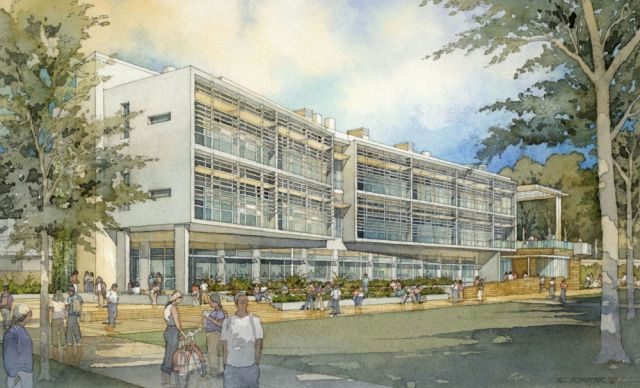State-of-the-Art Bioengineering Research Hub at UCSB to Break Ground this Summer with $74.3 Million in Funding

An architect's rendering of the Bioengineering Center
Nearly four years after plans were approved by University of California Regents, UCSB has finally secured funds for the $74.3 million Bioengineering Center. The economic downturn had put construction on hold, however UCSB Chancellor Henry T. Yang’s recent efforts secured $26.5 million in state funding. The remaining funds for the project will come from Garamendi bonds, which allow the university to pay off the bonds using revenues gained from research conducted in the building.
The three-story, 48,000-square-foot building will house the university's Institute for Collaborative Biotechnologies (ICB) and the Center for Bioengineering (CBE). It will also contain 15 faculty offices, several conference rooms, an auditorium, a classroom, and laboratory space for as many as 110 researchers.
In a local news article Professor Frank Doyle, UCSB Associate Dean of Engineering for Research and Director of the ICB said “The purpose of the research hub is to pull together students and faculty members from multiple disciplines. That type of collaboration has been happening on campus for decades, but sometimes it's a matter of luck that researchers and research groups with complementary research, find each other and work together. The building is going to try to pull in those researchers so there's a better chance of amplifying or accelerating projects and studies with the same kinds of focus."
Having a research hub could make UCSB more competitive in the bioengineering field, where there are a growing number of job opportunities worldwide. A report released by the U.S. Department of Labor's Bureau of Labor Statistics estimates 62 percent job growth in the field from 2010 to 2020.
"This investment in campus resources reflects UCSB's growing prominence in research at the interface of the life sciences and engineering. We already enjoy a reputation for research excellence in these fields but this investment will ensure that we continue to grow and excel in our endeavors as they require more complex laboratory facilities to conduct the research," Professor Doyle said.
In 2007 rankings by the Chronicle of Higher Education placed UCSB No. 2 in the nation — behind only Duke University — for biomedical engineering research impact, even without a centralized academic program or physical location.
The new center would not only enable the kind of collaborations and synergies that lead to breakthroughs and discoveries inspired by both biology and engineering but also provide a vantage point from which UCSB can enhance its own bioengineering academic offerings. Currently the university offers a bioengineering undergraduate concentration through the College of Creative Studies and a Ph.D. emphasis through several departments on campus; the new physical hub for research will make it possible to offer an undergraduate major and an independent Ph.D. program with new faculty selected for their expertise in bioengineering.
